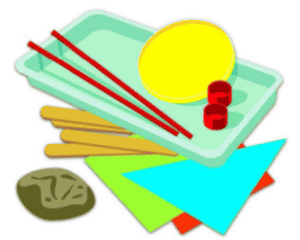Overview
Materials
Per Group of Approx. 6:
|
Per Class:
|
Instructions
Students realize the utility of reusing materials when they create their own toy boats out of them, while also experimenting with the effects of wind.
PREPARATION:
- Set up the boat building area so that children have access to a range of materials that inspire creativity.
- Set up the boat sailing area so that groups of children can test their boats on the water and make them sail.
ACTIVITY:
- Talk about the photos on display, asking such questions as, which of these photos shows a windy day? How can you tell? What kinds of boats do you see? Which photos show things made out of recycled materials?
- Explain that today students will create their own boats made out of reused materials. Show students the materials they can use, and point out the recycled symbol on various items. Tell them to be on the lookout for the recycled symbol as they build.
- Let students build their boats, providing guidance as needed.
 Encourage lots of different designs.
Encourage lots of different designs. - Ask students to blow on their hands, first softly and then as hard as they can. Note that a soft breath is like a breeze, and their hardest breath is more like wind. Then show them other ways to make air move, such as blowing through a straw or fanning the air with cardboard.
- Invite students to put their boats in the water and see how they can make them move with the wind. Challenge them to make their boats move in different directions. As an option, use the battery-operated fans to create wind, but be careful to keep them out of the water.
Guiding questions
-
What kind of boat do you want to make?
-
If your boat is tilting, how can you make it sit upright?
-
Which materials are best for attaching sails or parts to your boat?
-
How could you change your design to make it go even faster in the wind?
-
Why is it important to reuse and recycle?
Engineering & science connections
- Engineers design wind turbines, which work much the same way as pinwheels. Wind turbines range in size, but the average height of a typical electricity-generating wind turbine is about 325 feet, which is the same as a 30-story skyscraper!
- Wind turbines convert the kinetic energy of wind to mechanical energy in rotors. Then the rotors convert mechanical energy to electrical energy in a generator, which spins special magnets around a wire to induce an electrical charge.
- Both pinwheels and wind turbines have to be designed to catch as much wind as possible without breaking under stress. This means figuring out the best curves for the blades and how to best angle them toward the wind. And also figuring out which materials are light enough to spin, but strong enough to resist tearing.
Curious George is a production of Imagine, WGBH and Universal. Curious George and related characters, created by Margret and H.A. Rey, are copyrighted and trademarked by Houghton Mifflin Harcourt and used under license. Licensed by Universal Studios Licensing LLC. Television Series: © 2013. Universal Studios. All Rights Reserved. The PBS KIDS logo is a registered mark of PBS and is used with permission. Proud Sponsors of Curious George® on PBS KIDS® are Stride Rite Children’s Group, LLC., and ABCmouse.com.


0 Comments